SPARTH Collapsing Empire - Preliminary Sketch Digital

SPARTH Collapsing Empire - Preliminary Sketch Digital
More Posts from Epic-flight and Others







Artworks by Lucio Perinotto
1936-1945 | Boeing B-17 Flying Fortress
1953-1959 | North American F-100 Super Sabre
1936-1942 | Latécoère Laté 298
1941-1945 | Hawker Typhoon
1934-1936 | Caudron C.460 Racer
1938-1948 | Supermarine Spitfire
1936-1945 | Boeing B-17 Flying Fortress
You Are Made of Stardust
Though the billions of people on Earth may come from different areas, we share a common heritage: we are all made of stardust! From the carbon in our DNA to the calcium in our bones, nearly all of the elements in our bodies were forged in the fiery hearts and death throes of stars.
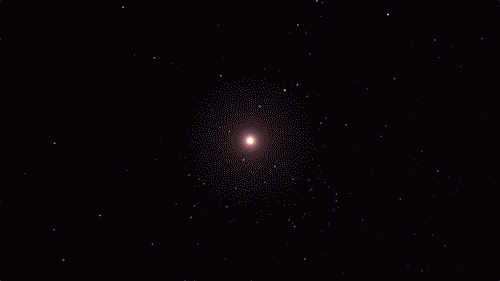
The building blocks for humans, and even our planet, wouldn’t exist if it weren’t for stars. If we could rewind the universe back almost to the very beginning, we would just see a sea of hydrogen, helium, and a tiny bit of lithium.
The first generation of stars formed from this material. There’s so much heat and pressure in a star’s core that they can fuse atoms together, forming new elements. Our DNA is made up of carbon, hydrogen, oxygen, nitrogen, and phosphorus. All those elements (except hydrogen, which has existed since shortly after the big bang) are made by stars and released into the cosmos when the stars die.

Each star comes with a limited fuel supply. When a medium-mass star runs out of fuel, it will swell up and shrug off its outer layers. Only a small, hot core called a white dwarf is left behind. The star’s cast-off debris includes elements like carbon and nitrogen. It expands out into the cosmos, possibly destined to be recycled into later generations of stars and planets. New life may be born from the ashes of stars.
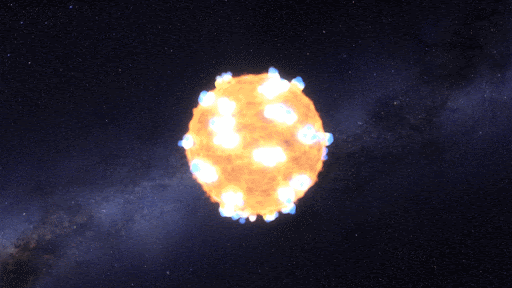
Massive stars are doomed to a more violent fate. For most of their lives, stars are balanced between the outward pressure created by nuclear fusion and the inward pull of gravity. When a massive star runs out of fuel and its nuclear processes die down, it completely throws the star out of balance. The result? An explosion!
Supernova explosions create such intense conditions that even more elements can form. The oxygen we breathe and essential minerals like magnesium and potassium are flung into space by these supernovas.
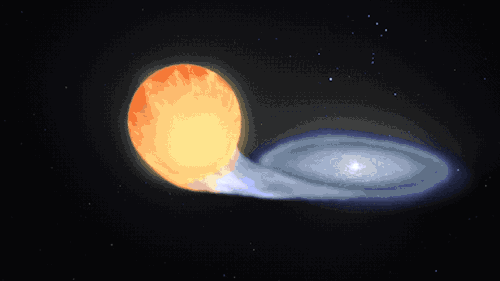
Supernovas can also occur another way in binary, or double-star, systems. When a white dwarf steals material from its companion, it can throw everything off balance too and lead to another kind of cataclysmic supernova. Our Nancy Grace Roman Space Telescope will study these stellar explosions to figure out what’s speeding up the universe’s expansion.
This kind of explosion creates calcium – the mineral we need most in our bodies – and trace minerals that we only need a little of, like zinc and manganese. It also produces iron, which is found in our blood and also makes up the bulk of our planet’s mass!

A supernova will either leave behind a black hole or a neutron star – the superdense core of an exploded star. When two neutron stars collide, it showers the cosmos in elements like silver, gold, iodine, uranium, and plutonium.

Some elements only come from stars indirectly. Cosmic rays are nuclei (the central parts of atoms) that have been boosted to high speed by the most energetic events in the universe. When they collide with atoms, the impact can break them apart, forming simpler elements. That’s how we get boron and beryllium – from breaking star-made atoms into smaller ones.
Half a dozen other elements are created by radioactive decay. Some elements are radioactive, which means their nuclei are unstable. They naturally break down to form simpler elements by emitting radiation and particles. That’s how we get elements like radium. The rest are made by humans in labs by slamming atoms of lighter elements together at super high speeds to form heavier ones. We can fuse together elements made by stars to create exotic, short-lived elements like seaborgium and einsteinium.
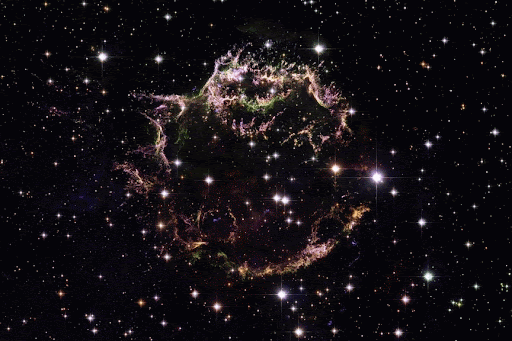
From some of the most cataclysmic events in the cosmos comes all of the beauty we see here on Earth. Life, and even our planet, wouldn’t have formed without them! But we still have lots of questions about these stellar factories.
In 2006, our Stardust spacecraft returned to Earth containing tiny particles of interstellar dust that originated in distant stars, light-years away – the first star dust to ever be collected from space and returned for study. You can help us identify and study the composition of these tiny, elusive particles through our Stardust@Home Citizen Science project.
Our upcoming Roman Space Telescope will help us learn more about how elements were created and distributed throughout galaxies, all while exploring many other cosmic questions. Learn more about the exciting science this mission will investigate on Twitter and Facebook.
Make sure to follow us on Tumblr for your regular dose of space!
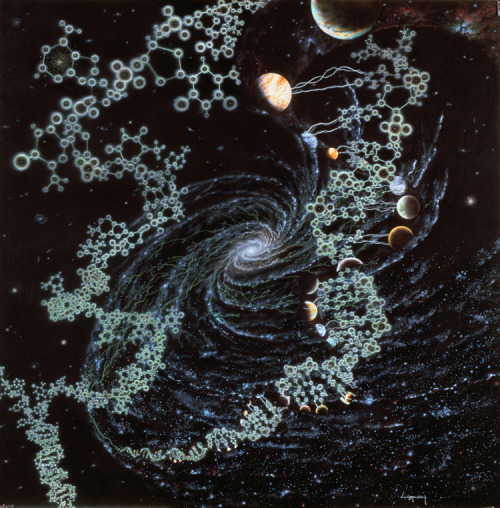
Jon Lomberg

Starbright.
Twitter / Instagram / Gumroad / Patreon
KnownOrigin / SuperRare / OBJKT /Zedge

Cosmic Entity.
Twitter / Instagram / Gumroad / Patreon
KnownOrigin / SuperRare / OBJKT / Zedge








Consolidator-class Corps Assault Ship - Ansel Hsiao

The Dark Seahorse in Cepheus : Light-years across, this suggestive shape known as the Seahorse Nebula appears in silhouette against a rich, luminous background of stars. Seen toward the royal northern constellation of Cepheus, the dusty, obscuring clouds are part of a Milky Way molecular cloud some 1,200 light-years distant. It is also listed as Barnard 150 (B150), one of 182 dark markings of the sky cataloged in the early 20th century by astronomer E. E. Barnard. Packs of low mass stars are forming within, but their collapsing cores are only visible at long infrared wavelengths. Still, the colorful stars of Cepheus add to this pretty, galactic skyscape. via NASA

Saturn seen from Titan, illustrated by David Egge, 1978.

Scorpius Rising, photographed from Mt. Laguna, California. (Hendren Imaging)

Young Stars of NGC 346 : The massive stars of NGC 346 are short lived, but very energetic. The star cluster is embedded in the largest star forming region in the Small Magellanic Cloud, some 210,000 light-years distant. Their winds and radiation sweep out an interstellar cavern in the gas and dust cloud about 200 light-years across, triggering star formation and sculpting the region’s dense inner edge. Cataloged as N66, the star forming region also appears to contain a large population of infant stars. A mere 3 to 5 million years old and not yet burning hydrogen in their cores, the infant stars are strewn about the embedded star cluster. In this false-color Hubble Space Telescope image, visible and near-infrared light are seen as blue and green, while light from atomic hydrogen emission is red. via NASA
-
 inevchanmequa liked this · 1 year ago
inevchanmequa liked this · 1 year ago -
 thecentroid liked this · 2 years ago
thecentroid liked this · 2 years ago -
 isaihdzglz25 liked this · 3 years ago
isaihdzglz25 liked this · 3 years ago -
 distresscalls liked this · 3 years ago
distresscalls liked this · 3 years ago -
 fmaynor2000 liked this · 3 years ago
fmaynor2000 liked this · 3 years ago -
 karagin22 liked this · 3 years ago
karagin22 liked this · 3 years ago -
 s0cr4t3s liked this · 3 years ago
s0cr4t3s liked this · 3 years ago -
 freenrg liked this · 4 years ago
freenrg liked this · 4 years ago -
 epic-flight reblogged this · 4 years ago
epic-flight reblogged this · 4 years ago -
 phatburd reblogged this · 4 years ago
phatburd reblogged this · 4 years ago -
 phatburd liked this · 4 years ago
phatburd liked this · 4 years ago -
 kalekemo reblogged this · 5 years ago
kalekemo reblogged this · 5 years ago -
 kalekemo liked this · 5 years ago
kalekemo liked this · 5 years ago -
 sffreads reblogged this · 5 years ago
sffreads reblogged this · 5 years ago -
 doomedyuri liked this · 5 years ago
doomedyuri liked this · 5 years ago -
 bentheoverlord liked this · 5 years ago
bentheoverlord liked this · 5 years ago -
 jsunizm liked this · 5 years ago
jsunizm liked this · 5 years ago -
 kremkim liked this · 6 years ago
kremkim liked this · 6 years ago -
 palililila liked this · 6 years ago
palililila liked this · 6 years ago -
 karafrench liked this · 6 years ago
karafrench liked this · 6 years ago -
 lovingnightmarecheesecake-blog liked this · 6 years ago
lovingnightmarecheesecake-blog liked this · 6 years ago -
 zixio liked this · 6 years ago
zixio liked this · 6 years ago -
 saphiiras liked this · 6 years ago
saphiiras liked this · 6 years ago -
 lecjr1970 liked this · 6 years ago
lecjr1970 liked this · 6 years ago -
 terryjax liked this · 7 years ago
terryjax liked this · 7 years ago -
 sh8dneji liked this · 7 years ago
sh8dneji liked this · 7 years ago -
 thegrandrectifier liked this · 7 years ago
thegrandrectifier liked this · 7 years ago -
 toawk reblogged this · 7 years ago
toawk reblogged this · 7 years ago -
 toawk liked this · 7 years ago
toawk liked this · 7 years ago -
 thesugacito-blog reblogged this · 7 years ago
thesugacito-blog reblogged this · 7 years ago -
 thesugacito-blog liked this · 7 years ago
thesugacito-blog liked this · 7 years ago -
 leerraeume reblogged this · 7 years ago
leerraeume reblogged this · 7 years ago -
 genowindbirds-artpage liked this · 7 years ago
genowindbirds-artpage liked this · 7 years ago -
 golden-hour-babe liked this · 7 years ago
golden-hour-babe liked this · 7 years ago -
 hawtorne reblogged this · 7 years ago
hawtorne reblogged this · 7 years ago -
 cutright880-blog liked this · 7 years ago
cutright880-blog liked this · 7 years ago
